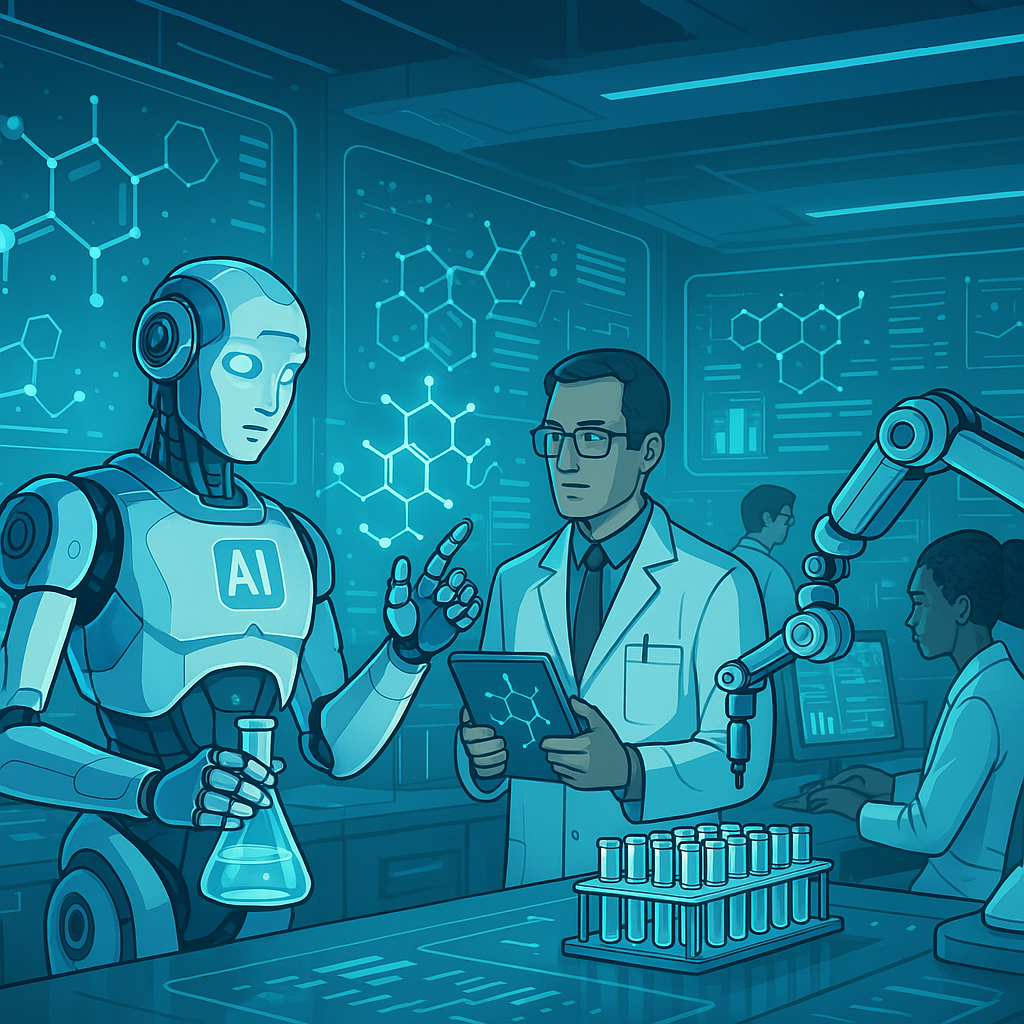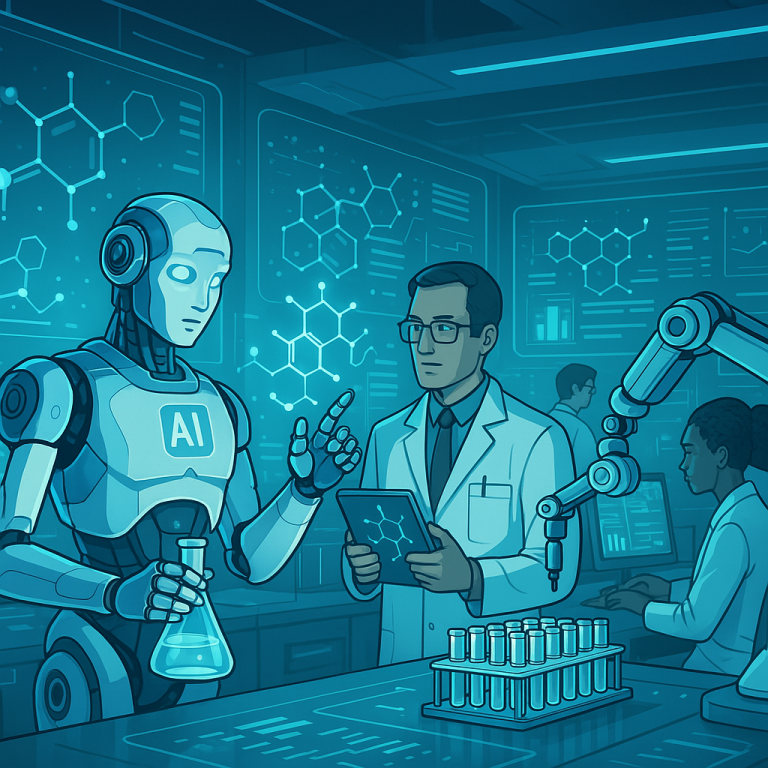From Discovery to Targeted Therapy
The pharmaceutical industry, traditionally characterized by lengthy, costly, and often uncertain processes, is undergoing a profound transformation thanks to Artificial Intelligence (AI). From the initial stages of drug discovery to ensuring molecule stability and compatibility for targeted therapies, AI is proving to be a game-changer, significantly cutting down trial and testing times and accelerating the delivery of life-saving medicines.
The Traditional Drug Development Bottleneck
Historically, bringing a new drug to market has been an arduous journey, typically taking 10 to 15 years from initial discovery to regulatory approval, with costs often exceeding $1 billion to $2 billion USD. The discovery and preclinical phases alone could consume 4 to 7 years, followed by clinical trials spanning another 6 to 10 years. This lengthy timeline was largely due to manual, iterative processes, extensive physical experimentation, and a high failure rate at every stage.
Accelerating Drug Discovery and Design
The journey of a new drug begins with identifying a suitable molecular compound. This phase, historically a laborious process of trial and error, is now being supercharged by AI.

- Virtual Screening and Lead Optimization: AI algorithms can rapidly screen vast databases of chemical compounds, identifying those with the highest potential to bind to specific disease targets (e.g., proteins, enzymes). Unlike traditional high-throughput screening, which is physically intensive, AI performs this virtually, sifting through billions of molecules in a fraction of the time. Machine learning models can then optimize these “lead” compounds, refining their structure to enhance efficacy and reduce off-target effects.
- De Novo Drug Design: Beyond screening existing compounds, generative AI models (like Generative Adversarial Networks or GANs) can design entirely novel molecular structures from scratch. By learning the chemical properties and biological activities of known drugs, these AI systems propose new compounds with desired characteristics, opening up unprecedented avenues for therapeutic innovation.
- Predicting Drug-Target Interactions: AI leverages deep learning to predict how a potential drug molecule will interact with biological targets within the body. This includes understanding binding affinities, conformational changes, and potential enzymatic reactions, allowing researchers to prioritize candidates with the most promising therapeutic profiles.
Enhancing Molecule Stability and Compatibility for Targeted Therapy
Once a potential drug candidate is identified, its journey is far from over. Ensuring its stability, bioavailability, and compatibility with specific patient populations is crucial. AI offers significant advantages here:
- Predicting Pharmacokinetic (ADME) Properties: AI models can accurately predict a molecule’s Absorption, Distribution, Metabolism, and Excretion (ADME) properties. This early insight helps in selecting compounds that will be effectively absorbed by the body, reach their intended target, be metabolized safely, and eliminated efficiently, thereby reducing the likelihood of late-stage failures due to poor pharmacokinetics.
- Assessing Toxicity and Side Effects: Before costly animal and human trials, AI can predict potential toxicity and adverse drug reactions by analyzing molecular structures and their interactions with various biological pathways. This early warning system helps de-risk drug candidates, allowing researchers to discard problematic compounds much earlier in the development pipeline.
- Optimizing Formulations: AI can model how different excipients (inactive ingredients) and manufacturing processes affect a drug’s stability, solubility, and shelf-life. This optimization ensures that the drug remains effective and safe throughout its intended storage and use, reducing waste and improving patient access.
- Targeted Therapy Compatibility: The rise of personalized medicine and targeted therapies demands drugs that are effective for specific patient subgroups (e.g., those with particular genetic mutations or biomarkers). AI analyzes vast datasets of patient genomic, proteomic, and clinical data to predict which molecules will be most effective for a given patient profile, ensuring higher success rates and fewer adverse events in clinical settings.
Streamlining Clinical Trials and Testing
Perhaps one of AI’s most impactful contributions is in shortening the traditionally protracted and expensive clinical trial phase.
- Patient Stratification and Recruitment: AI algorithms can analyze patient data to identify individuals most likely to respond to a particular drug or who fit specific trial criteria. This precise patient stratification accelerates recruitment, reduces patient heterogeneity in trials, and improves the statistical power of studies, leading to clearer results.
- Predicting Trial Outcomes: Machine learning models can analyze preclinical data, early-phase clinical trial results, and real-world evidence to predict the likelihood of success or failure for a drug candidate in later-stage trials. This foresight allows pharmaceutical companies to make informed go/no-go decisions, saving billions by avoiding investment in destined-to-fail compounds.
- Optimizing Trial Design: AI can optimize trial protocols, including dosage regimens, duration, and endpoints, to maximize efficiency and data quality. It can also identify optimal sites for trials based on patient demographics and research infrastructure.
- Real-time Monitoring and Data Analysis: During trials, AI tools can continuously monitor patient data for safety signals and efficacy trends, providing real-time insights that enable quicker adjustments or early termination if necessary. This dynamic approach ensures patient safety and trial integrity.
- Reducing Physical Testing Time: By performing extensive virtual screening, predictive modeling of ADME/Tox properties, and simulating molecular interactions, AI significantly reduces the need for countless physical experiments and animal tests, thereby compressing the overall R&D timeline.
AI-Powered Breakthroughs: Record Time and “Impossible” Cures
AI has already demonstrated its capability to dramatically accelerate drug development and tackle diseases previously considered intractable.
- Record-Breaking Development Times:
- Halicin: Discovered by MIT scientists using AI, this novel antibiotic was identified in a fraction of the time it would have taken through traditional methods, proving effective against highly drug-resistant bacteria like Clostridium difficile and Mycobacterium tuberculosis.
- Insilico Medicine’s IPF Drug (Rentosertib/ISM001-055): This drug candidate for Idiopathic Pulmonary Fibrosis (IPF) went from target identification to preclinical trials in just 18 months, a process that typically takes 4-6 years. It has since shown positive Phase IIa clinical trial data.
- Exscientia & Sumitomo Dainippon Pharma’s OCD Drug (DSP-1181): This AI-designed molecule entered human clinical trials in less than 12 months, marking a significant milestone in AI-driven drug development.
- Takeda’s Psoriasis Drug: An AI system selected a promising compound for psoriasis in just 6 months, a task that would have required years of human effort.
- Tackling “Impossible” and Rare Diseases:
- Rare Diseases: AI is particularly impactful for rare diseases, where limited patient data and complex symptoms make traditional drug development challenging. AI excels at analyzing sparse datasets and identifying potential drug repurposing opportunities for thousands of conditions with no current treatments.
- Amyotrophic Lateral Sclerosis (ALS): AI has identified numerous new potential genetic targets for ALS, a progressive and currently incurable neurological disease. Many of these targets have been validated, opening new avenues for treatment.
- Spinal Muscular Atrophy (SMA): AI significantly accelerated the identification and development of antisense oligonucleotides (ASOs) for SMA, a severe genetic disorder.
- Cancer: AI is being leveraged to identify highly specific neoantigens for personalized cancer vaccines, discover new drugs that inhibit enzymes implicated in various cancer types (e.g., breast and prostate cancer), and transform overall cancer care through advanced AI models for diagnosis and treatment.
- Autoimmune and Autoinflammatory Diseases: AI has led to the nomination of novel drug candidates, such as a TYK2 inhibitor, with the potential to treat a wide range of these complex immune-mediated conditions.
Challenges and Future Outlook
While AI’s potential is immense, challenges remain, including the need for high-quality, diverse datasets, regulatory adaptation to AI-driven drug development, and ethical considerations surrounding data privacy. However, as AI technologies mature and integrate further into the pharmaceutical workflow, we can anticipate a future where drug development is faster, more cost-effective, and ultimately, more successful in addressing unmet medical needs.
Conclusion
AI is not just an incremental improvement; it is a fundamental shift in how drugs are discovered, developed, and delivered. By enhancing predictive capabilities, automating complex analyses, and optimizing every stage of the pipeline, AI is empowering the pharmaceutical industry to bring safer, more effective, and precisely targeted therapies to patients with unprecedented speed, ushering in a new era of medical innovation.




